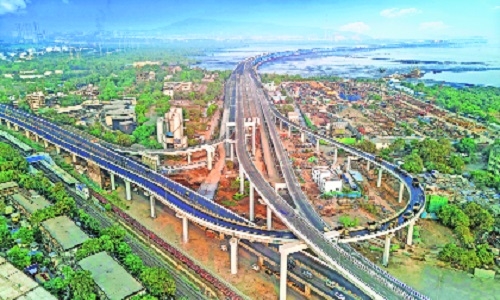Need to develop infra with environmental balance
| Date :10-Jan-2024 |

By Arun Kumar Shrivastav
The development of Mumbai and Navi Mumbai is undeniably crucial but cannot come at the cost of environmental degradation. To navigate this tightrope, a paradigm shift is necessary: Embracing eco-friendly construction practices like using recycled materials, minimising dredging, and actively planting mangroves can mitigate ecological damage. Building robust metro lines and bus networks can encourage people to leave their cars behind, reducing traffic congestion and air pollution.
AS PRIME Minister Narendra Modi is slated to inaugurate the 22-kilometer Mumbai Trans Harbour Link (MTHL) on January 12, it’s time to look at the fragile ecology yet expanding infrastructure ecosystem of Mumbai. MTHL, India’s longest sea bridge, snakes gracefully across the Thane Creek, connecting Navi Mumbai to Mumbai. This engineering marvel promises to slash travel times between the two cities, unlocking new economic integration and development avenues.
The City of Dreams pulsates with ambition and relentless energy. Home to over 20 million inhabitants, it grapples with the typical challenges of a megacity – choked roads, overburdened infrastructure, and a constantly expanding footprint. Yet, Mumbai dreams big, and its latest undertakings reflect this spirit.
Mumbai’s land area is less than one-third of Delhi’s, yet it is home to a larger population. That speaks of the population density and the importance of mobility in this mega city. Besides, Mumbai has 167 km of continuous coastline. New infra projects are constantly battering the ecology of this precious coastline. The area between Mumbai and Pune is nestled in the Sahyadri range. Still, there is hardly any environmental concern for the mountain forest ecosystem regarding greenlighting residential or infrastructure projects.
Three colossal projects – the Mumbai Trans Harbour Link, the Mumbai Coastal Road, and the Navi Mumbai International Airport – promise to reshape the city’s landscape. These ambitious endeavours promise to bridge geographical divides, fuel economic growth, and propel Mumbai onto the global stage. But beneath the celebratory fanfare lies a critical question: can these dreams be realised without compromising the city’s environmental well-being?
The 84-kilometre Mumbai Coastal Road, envisioned as a scenic highway, aims to untangle the city’s notorious traffic snarls. By carving a path along the Arabian Sea, it aspires to ease congestion and open up Mumbai’s picturesque waterfront.
Scheduled to take off by the end of 2024, the Navi Mumbai International Airport promises to propel the region into the global aviation hub league. This state-of-the-art facility will cater to passenger and cargo traffic, further bolstering Mumbai’s economic prowess.
While these projects exude the aura of progress and prosperity, a disquieting undercurrent of environmental concerns runs through them. Experts and environmentalists picture potential ecological disruption, traffic chaos, and waste management woes.
The construction of the Trans Harbour Link has claimed vast swathes of mangroves, vital ecosystems that protect coastlines from erosion and nurture marine life. Their destruction disrupts the delicate balance of Thane Creek, potentially impacting biodiversity and the overall health of the ecosystem.
While the Trans Harbour Link and Coastal Road promise to decongest existing roads, concerns linger about their impact on already overburdened areas in Mumbai. Increased traffic might shift the problem, leading to a surge in air and noise pollution, jeopardising public health.
The sheer scale of these projects generates mountains of construction waste. Improper disposal of this debris can pollute landfills and waterways, further straining the environment.
The development of Mumbai and Navi Mumbai is undeniably crucial but cannot come at the cost of environmental degradation. To navigate this tightrope, a paradigm shift is necessary:
Embracing eco-friendly construction practices like using recycled materials, minimising dredging, and actively planting mangroves can mitigate ecological damage. Building robust metro lines and bus networks can encourage people to leave their cars behind, reducing traffic congestion and air pollution.
Implementing efficient waste disposal mechanisms is essential to prevent environmental contamination.
Engaging local communities in waste segregation and recycling initiatives can further bolster these efforts. Mumbai’s future hangs in the balance, delicately poised between progress and peril. Embracing sustainable practices and prioritising environmental considerations alongside development is not just an option but an imperative. By walking the path of responsible progress, local bodies -- Brihanmumbai Municipal Corporation (BMC) and Navi Mumbai Municipal Corporation (NMMC) -- can ensure that Mumbai’s dreams take flight, not at the cost of its ecological well-being, but in harmony with it.
These projects should not be viewed as isolated endeavours but as part of a larger vision for sustainable urban development. Integrating environmental considerations into urban planning and infrastructure development is critical to long-term sustainability. By adopting a data-driven, analytical approach and prioritising environmental sustainability, Mumbai’s mega projects can evolve from mere feats of engineering into beacons of responsible progress. Only then can Mumbai truly fulfill its potential as a thriving metropolis that balances the needs of its people with the delicate yet vital needs of the environment, paving the way for a future where progress and sustainability go hand-in-hand.
